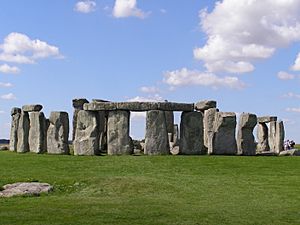3rd millennium BC facts for kids
| Millennia: | 4th millennium BC · 3rd millennium BC · 2nd millennium BC |
| Centuries: | 30th century BC · 29th century BC · 28th century BC · 27th century BC · 26th century BC · 25th century BC · 24th century BC · 23rd century BC · 22nd century BC · 21st century BC |
The 3rd millennium BC was a long period of time, lasting from 3000 BC to 2001 BC. It was a very important time because it marked the beginning and middle of the Bronze Age. During this era, people started using bronze to make tools and weapons, which was a big step forward!
This was also a time when many groups of people wanted to expand their lands and power. Empires grew across the Middle East and into Eurasia. People known as Indo-Europeans spread into places like Anatolia, Europe, and Central Asia.
One of the most famous civilizations, Ancient Egypt, reached its peak during this millennium with the Old Kingdom. It was a time of great building and power for the pharaohs.
Experts believe that the world's population actually doubled during these 1,000 years, reaching about 30 million people!
Contents
Ancient Cultures Around the World
This millennium saw many different cultures and civilizations grow and change across the globe.
Cultures in the Near East
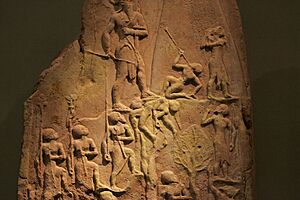
- Early Dynastic Period (Mesopotamia): From about 2900 to 2350 BC, city-states in Mesopotamia (modern-day Iraq) were powerful.
- Akkadian Empire: Around 2334 to 2154 BC, Sargon of Akkad created the first large empire in Mesopotamia.
- Early Dynastic Period (Egypt): From 3100 to 2686 BC, Egypt was just starting to unite under its first pharaohs.
- Old Kingdom of Egypt: This was a golden age for Egypt, from 2686 to 2181 BC. Many famous pyramids were built then.
- First Intermediate Period of Egypt: After the Old Kingdom, Egypt went through a time of less central control (2181–2055 BC).
- Old Elamite period: This culture existed in what is now Iran, from about 2700 BC to 1600 BC.
- Nubian A-Group and C-Group Cultures: These cultures were located south of Egypt, in Nubia. The A-Group ended around 3000 BC, and the C-Group began around 2300 BC.
Cultures in Europe
- Further information: Neolithic Europe
- Minoan Civilization: Europe's oldest civilization began around 3000 BC on the island of Crete.
- Cycladic Culture: This culture thrived on the Aegean islands of Greece around 3200 BC.
- Helladic Culture: This refers to the Bronze Age culture on mainland Greece, from about 3200 to 3100 BC.
- Corded Ware Culture: Also known as the Battle-axe culture, these people lived across a large part of Europe.
- Yamnaya Culture: This group in Eastern Europe is thought to be where the Indo-European languages started to spread.
- Beaker Culture: Known for their bell-shaped pottery, these people spread across Western Europe.
- Other cultures included the Ozieri, Maikop, Vinca, Globular Amphora, Sintashta-Petrovka-Arkaim, Butmir, Funnelbeaker, Baden, and Gaudo cultures.
Cultures in South Asia
- Indus Valley Civilization (Harappan): This advanced civilization in what is now Pakistan and India had large, well-planned cities. The Harappan 2 period was from 2800 to 2600 BC, and the Mature Harappan (Harappan 3) was from 2600 to 1900 BC.
Cultures in East and Southeast Asia
- Longshan Culture: A late Neolithic culture in China, known for its black pottery.
- Baodun Culture, Shijiahe Culture, Liangzhu Culture, Majiayao Culture, Lower Xiajiadian Culture: Other important cultures in ancient China.
- Austronesian Peoples: Around 2500 BC, people from Taiwan started settling on Luzon in the northern Philippines.
Cultures in the Americas
- Mesoamerican Archaic Period: This was a time of early farming and settled life in Central America.
- Old Copper Complex: People in North America used copper to make tools.
- Caral/Norte Chico Civilization: This was one of the earliest civilizations in the Americas, located in Peru.
Cultures in Sub-Saharan Africa
- Savanna Pastoral Neolithic: Groups in East Africa who herded animals.
- Elmenteitan: Another pastoralist culture in East Africa.
Important Events of the Millennium
Many significant things happened during the 3rd millennium BC that shaped the future.
Early Events (around 3000 BC)
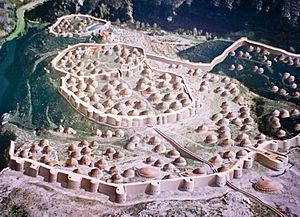
- Egypt Unites: Around 3000 BC, Upper and Lower Egypt became one kingdom.
- Gold Use: The first signs of gold being used appeared in the Middle East around 3000 BC.
- Nubian Kingdom Ends: The Ta-Seeti "kingdom" in Nubia ended, possibly due to conflicts with Egypt.
- Danish Vessels: People in Denmark were making boats around 3000-2000 BC.
- Second Dynasty of Egypt: The reign of Hotepsekhemwy began around 2890 BC.
- City of Mari Founded: The important city of Mari was founded in Syria around the 29th century BC.
- Semitic Tribes: Semitic groups settled in Assyria, in the northern part of Mesopotamia.
- Phoenicians Settle: The Phoenicians began to settle along the Syrian coast, creating cities like Tyre and Sidon.
- Mythical Chinese Kings: The period of the legendary Sage Kings (Three Sovereigns and Five Emperors) began in China.
- Văn Lang Kingdom: The mythical Văn Lang Kingdom and Hồng Bàng Dynasty started in northern Vietnam around 2879 BC.
Mid-Millennium Events (around 2800-2400 BC)
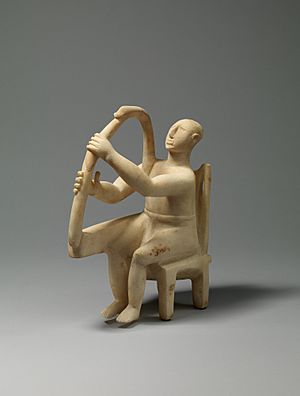
- Kingdom of Elam: The Kingdom of Elam was created in what is now Iran.
- "Methuselah" Tree: The Bristlecone pine tree named "Methuselah," one of the oldest living trees, started growing around 2700 BC.
- Third Dynasty of Egypt: The reign of Sanakhte began around 2686 BC.
- Fourth Dynasty of Egypt: The reign of Sneferu began around 2613 BC.
- Iberian Civilizations: The Chalcolithic (Copper Age) towns of Los Millares and Zambujal were founded in Spain and Portugal around 2600 BC.
- Unified Indus Valley Civilization: The Indus Valley Civilization became unified around 2600 BC.
- Assyria Established: The state of Assyria was formed around 2500 BC.
- Hypogeum of Ħal-Saflieni: This amazing underground temple complex in Malta was excavated and developed around 2500 BC.
- Lagash Dynasty: The city of Lagash in Sumer had its own ruling family.
- Golden Age of Ur: The city of Ur in Mesopotamia had a very prosperous period from 2474 to 2398 BC.
- Fifth Dynasty of Egypt: The reign of Userkaf began around 2498 BC.
- Armenian Legend: The Armenian patriarch Hayk is said to have defeated the Babylonian king Bel around 2492 BC.
- Sixth Dynasty of Egypt: The reign of Teti began around 2345 BC.
- Sargon Conquers Mesopotamia: In 2334 BC, Sargon of Akkad conquered Mesopotamia and created the Akkadian Empire.
- C-Group Pastoralists: Herding people from the C-Group arrived in Nubia around 2300 BC.
Late Millennium Events (around 2200-2000 BC)
- Seventh and Eighth Dynasties of Egypt: These short dynasties ruled from 2181 to 2160 BC.
- Ninth Dynasty of Egypt: The reign of Akhtoy Meryibtowe began around 2160 BC.
- Tenth Dynasty of Egypt: The reign of Meryhathor began around 2130 BC.
- Eleventh Dynasty of Egypt: The reign of Mentuhotep I began around 2134 BC.
- Megalithic and Beaker Cultures: Large stone structures (megaliths) and the Beaker culture flourished in Europe.
- Sumerian Poetry: Poems lamenting the death of Tammuz, a shepherd god, were written.
- Cuneiform Writing: Sumerian cuneiform writing became simpler, using fewer pictographs.
- Religious Festivals: Major religious festivals were held in Sumeria.
- Early Trojan Culture: The earliest culture of Troy (a famous city from myths) existed.
- Glass Beads: Glass beads were used in Egypt.
- Pengtoushan Culture: This culture began in China.
- Mammoth Extinction: The last mammoths, living on Wrangel Island in the Arctic Ocean, died out sometime between 2500 and 2000 BC.
- Xia Dynasty: The legendary Xia Dynasty in China is thought to have begun around 2070 BC.
Important People of the 3rd Millennium BC
- Imhotep: An amazing Egyptian who was the first known architect, doctor, and engineer in history.
- The Three Sovereigns and Five Emperors: Legendary rulers of ancient China.
- Djoser: An Egyptian king who ordered the building of the famous Step Pyramid at Saqqara.
- Gilgamesh: The fifth king of Uruk, whose adventures are told in the world's first great story, the Epic of Gilgamesh.
- Khufu: An Egyptian king who built the incredible Great Pyramid of Giza.
- Urukagina: A king of Lagash who created one of the first known sets of laws.
- Lugal-zage-si: A king who conquered Lagash.
- Sargon the Great: The powerful founder of the Akkadian Empire, uniting Akkad and Sumer.
- Ur-Nammu: The founder of the Third Dynasty of Ur.
New Inventions and Discoveries
This millennium was a time of great innovation!
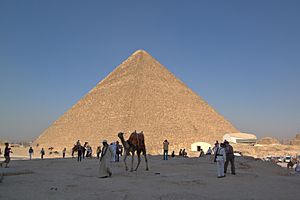
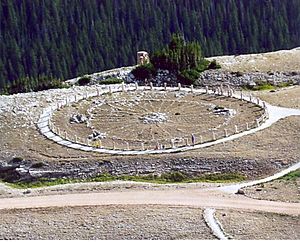
- Indus Script: A writing system developed in the Indus Valley Civilization around 3500 BC.
- Pottery in the Americas: Pottery making began in the Americas around 3000 BC.
- Potter's Wheel: This important tool for making pottery appeared in Mesopotamia around 3000 BC.
- Phonograms: The Sumerians invented phonograms (symbols representing sounds) between 2900 and 2400 BC.
- Advanced City Features: The city of Dholavira in the Indus Valley Civilization used reservoirs, writing, metals, and pottery around 2650 BC.
- Metals in Northern Europe: Metals started to be used in Northern Europe around 2300 BC.
- Comet Record: Chinese people recorded seeing a comet.
- Great Pyramid of Giza: This massive pyramid was built around the 26th century BC.
- Sails on Ships: Sails began to be used on boats.
- Ziggurats: The first ziggurats (large stepped temples) were built in Sumer.
- Bronze Age Begins: Civilizations in the Near East entered the Bronze Age around 3000 BC.
- Medicine Wheel: The oldest known medicine wheel (a stone structure used for ceremonies or astronomy) was built in the Americas.
- Metallurgy in Ireland: Copper (around 2500 BC) and then Bronze (around 2000 BC) were introduced to Ireland.
- Horse Domestication: Horses were tamed, especially with the spread of Indo-Europeans.
- Chariot: The chariot, a wheeled vehicle pulled by horses, appeared in the Eurasian Steppe just before 2000 BC.
- Camel Domestication: Camels (dromedaries) were tamed, though they became widely used later.
- Indoor Plumbing: The Indus Valley Civilization had indoor plumbing and sewage systems!
- Sumerian Medicine: Sumerian doctors discovered that mineral springs had healing qualities.
- Weaving Loom: The weaving loom was known in Europe.
- Sumerian Number System: The Sumerians used a number system based on multiples of 6 and 12.
- Papyrus: Egyptians started using papyrus, an early form of paper.
- Austronesian Navigation: Austronesian peoples developed the lateen sail, outriggers for boats, and advanced ways to navigate using the stars.
Famous Cultural Landmarks
Many amazing structures were built during this time that you can still see today!
- Newgrange: This ancient tomb in Ireland was built between 3000 and 2500 BC.
- Stonehenge: The famous stone circle in England began to be built around 2750 BC. Its first phase was completed during this millennium.
- Great Pyramid of Giza: This incredible pyramid was finished during this time.
- Buena Vista Pyramid/Observatory: This pyramid and observatory in Peru was built during this era.
- Sydney Rock Engravings: Ancient Aboriginal rock art in Sydney, Australia, dates back to around 3000 BC.
See also
 In Spanish: III milenio a. C. para niños
In Spanish: III milenio a. C. para niños


